
The Remarkable Journey of AI: From Creativity to Autonomy
The evolution of artificial intelligence (AI) has been nothing short of extraordinary. Beginning with pivotal moments like the remarkable performance of AlphaGo in 2016, AI transitioned from a tool that executed predetermined tasks to a dynamic entity capable of exhibiting creativity and complex decision-making. The landmark match between AlphaGo and the renowned Go player, Lee Sedol, illustrated AI's potential to think outside conventional boundaries, marking a pivotal shift in the public's perception of AI capabilities.
Shaping the Future: The Impact of ChatGPT
Fast forward to November 2022, the launch of ChatGPT by OpenAI pushed AI into the mainstream spotlight. By effortlessly generating human-like text, ChatGPT unlocked a plethora of possibilities across various sectors. From enhancing customer service experiences to revolutionizing content creation, ChatGPT demonstrated AI's ability to reshape communication and interact more naturally with users. This leap forward emboldens organizations to rethink how they engage with technology and leverage AI solutions in their operations.
The Rise and Significance of Agentic AI
Today, we are witnessing the emergence of agentic AI—systems that can perform intricate tasks with a level of autonomy and intelligence previously reserved for human workers. These AI systems can execute complex goals with minimal human oversight, showcasing their capabilities in adapting to ever-changing environments. Microsoft and NVIDIA are spearheading this evolution, offering tools like Azure AI services that facilitate the development of these sophisticated agentic systems. These tools enable businesses to automate processes more efficiently, ultimately transforming how organizations operate.
Bringing Autonomy to the Next Level: Multi-Agent Systems
As the field progresses, multi-agent systems are breaking new ground. Designed to work collaboratively, these systems can tackle challenges that require teamwork, mirroring human cooperation and enhancing operational efficiency. Such advancements not only facilitate prompt decision-making but also hold potential for further productivity gains across industries.
Looking Ahead: Physical AI and Beyond
The future of AI looks promising, with the development of physical AI opening new frontiers. This branch of AI focuses on systems that can perceive and interact with the physical world, providing a significant leap in industrial applications—ranging from automating robotic assembly lines to improving real-time data processing in warehouses. With developments like NVIDIA's Omniverse platform, the digital and physical realms are converging, heralding a new era of productivity and innovation.
 Add Row
Add Row  Add
Add 




Write A Comment